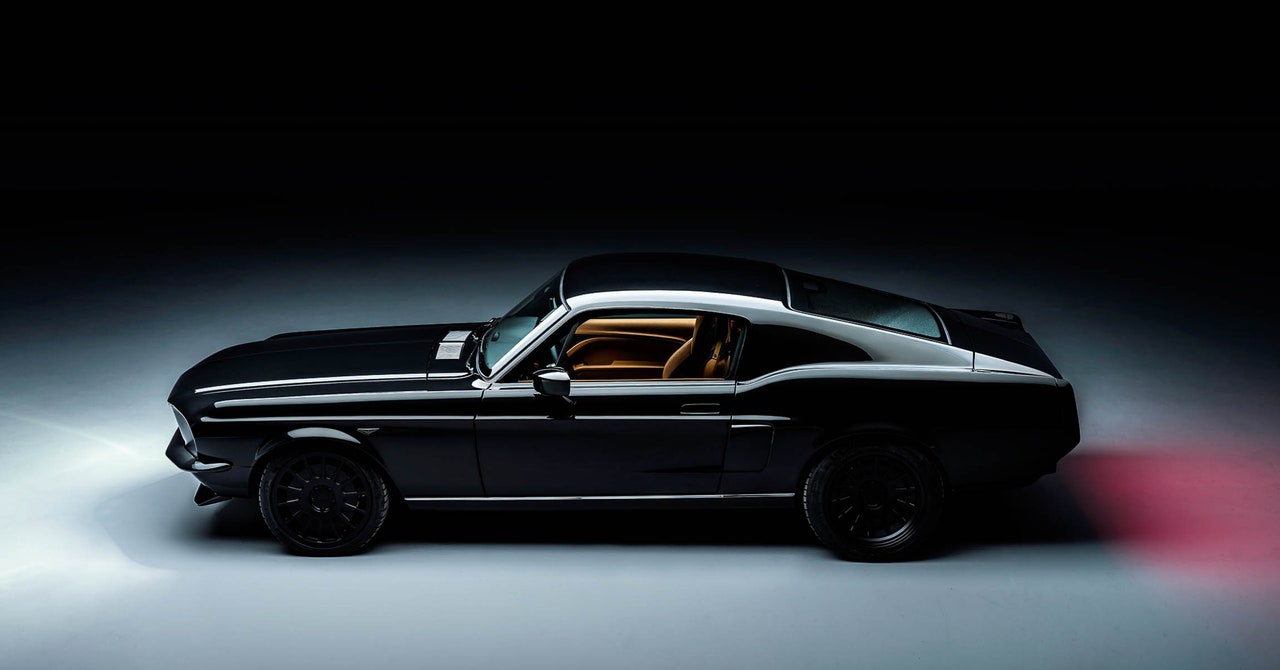[ad_1]
Cross-breeds are all the rage in the dog world right now. There’s the cockapoo, springador, puggle and labsky; the morkie, chiweenie and whoodle. The idea of these “designer dogs” is you get a kind of genetic Goldilocks breed, with the best characteristics from both parents: the loving loyalty of a retriever, for example, with the fluffy coat of a poodle.
And maybe what’s true in nature is also true in automotive engineering? It looks that way, judging by this car: This is the Charge ’67—and no, it’s not a restored classic with a V8 under the hood. It’s a brand-new EV, reimagined from the ground up as a purpose-built electric car.
Made in the UK, the ’67 is a mixture of two very different gene pools: It has the classic looks of the 1967 Ford Mustang Fastback, the car that Steve McQueen drove in his cult cop movie Bullitt; but under the skin it uses the hardware and software of EV start-up Arrival, which wants to revolutionize the world of commercial vehicles with its electric buses and delivery vans.
A Steve McQueen Mustang crossed with an electric van? This unlikely crossbreed dates back to 2015, when Arrival was founded in London by tech entrepreneur Denis Sverdlov. Sverdlov had a classic Ferrari Dino at the time, which was always leaking oil and breaking down. So he decided to create a new spinoff company that could apply his own, modular EV hardware to unreliable classics, like his Dino.
Charge Cars was founded in 2016, and Sverdlov then brought in Vadim Shagaleev—who’d previously run a video-on-demand business—to head up his new venture. Starting from scratch with a handful of Arrival engineers, Shagaleev’s first choice of prototype was his own favourite classic, the Mustang. But after buying an original 1967 car and considering an electric conversion (i.e., pulling out the existing drivetrain and installing a battery and motor), he realized this approach just wasn’t going to meet his and Sverdlov’s expectations. Old cars are, well … just old, and his classic Mustang was heavy, clunky, and full of rust.
So Shagaleev did some research and struck gold: He discovered a company in the US making brand-new, officially licensed Ford Mustang body shells to supply America’s healthy restoration market. Suddenly, instead of converting old classics, Charge could design its new EV on a blank (albeit Mustang-shaped) sheet of paper.
And this is where a third genetic influence comes into play, because after producing a proof-of-concept prototype, Shagaleev then hired Mark Roberts, formerly head of design operations at McLaren, the British supercar manufacturer. Joining as chief creative officer in 2020, Roberts not only brought with him huge experience, developing cars like the McLaren Senna and Speedtail, he also brought in other former colleagues, who in turn brought a very McLaren-like approach to the Charge project. “It’s a kind of accuracy, a level of technical excellence,” Roberts explains, when asked about this imported “McLaren-ness.” “We applied the same approach to surfacing this car—cleaning up the design and making the lines flow better. Then we created new lightweight body panels in carbon fiber, blending them seamlessly into the steel body shell.”
The design team also added contemporary touches like flush door handles and bespoke, jewel-like LED headlights and tail lamps. The result is strikingly modern, minimalist and pure, while retaining all the aggression and muscularity of the original 1960s design. It’s a sensational-looking car when you see it on the road—surprisingly compact by modern standards, but with a very big presence.
PHOTOGRAPH: GEORGE WILLIAMS/CHARGE CARS
Skin-Deep Styling
While it still looks like a Mustang, under the skin the car is transformed beyond all recognition. That steel body shell (basically the cockpit and roof) has been stiffened and strengthened, and a gaping hole has been engineered into the floor. This is then filled with the Arrival-sourced 64-kWh battery, encased in a rigid, carbon-fiber tray and bolted in underneath to become the structural floor. Charge reckons the range is around 200 miles.
Front and rear subframes are then attached to the shell, containing four 100-kW electric motors, one at each wheel, giving the car a total output of of 400 kW (536 bhp) and four-wheel drive. The suspension is also brand-new, with MacPherson struts at the front and wishbones at the rear, and the car is fitted with AP Racing brakes.
Open the door and you see that the interior has also been completely reimagined. There’s a three-spoke steering wheel that evokes the original Mustang’s, but otherwise it’s ultramodern inside, with sports seats, a streamlined dashboard with clean, horizontal air vents and two screens, one in the binnacle and a touchscreen in the middle.
[ad_2]
Source link

Leave a Reply